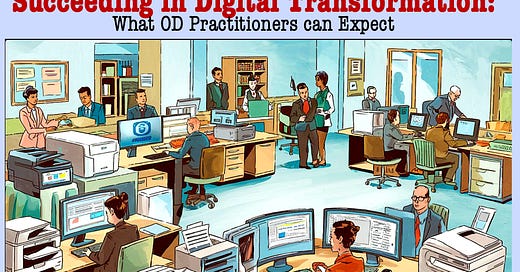In an ecosystem where technology permeates every aspect of our organizations, OD practitioners need not look farther than the public sector to learn about a disruptive but transformative change. Our public sector is riding the wave of digital transformation. Almost daily, an agency reports its digital transformation “quick wins.”
But what does this mean for the public sector organization and the citizens it serve? What can OD practitioners take from this presumably long term intervention? What are the indicators of successful implementation? Let's dive into the exciting world of digitally transformed public services.
What is Digital Transformation?
Digital transformation isn't just about the procurement of new gadgets and software. It's a fundamental shift in how organizations operate and deliver value for its intended constituencies. For the public sector, it means:
1. Leveraging new technologies to gain competencies that traditional organizations lack
2. Attracting (and more importantly, sustaining) the satisfaction of the citizens
3. Enhancing positivity among the behaviors of the constituencies
4. Continuously developing new and efficient ways of doing business
Imagining a Digitally Transformed Organization
Imagine a government that's as responsive and user-friendly as your favorite app or software. Here's what it might look (and perhaps, even feel) like:
-Integrated Digital Platforms. One-stop-shops for all your citizen services and needs
-Data-Driven Decision Making. Policies shaped by real-time insights, data and citizen’s feedback
-Mobile Accessibility. Government services in the citizen’s pocket
-Automated Processes. Say goodbye to long queues and paperwork
-Open Data Initiatives. Transparency at your fingertips
Streamlining Bureaucracy
While some bureaucracy is necessary, digital transformation can significantly reduce red tape:
- Streamlined approval processes
- Role-based access control for enhanced security
- Feedback loops for continuous improvement
Goodbye, Paperwork!
One of the most exciting prospects of digital transformation is the reduction (or even elimination) of paperwork:
- Digitized records for faster information retrieval
- E-signatures for quicker processing
- Online forms to improve data accuracy
- One source of information and one copy per document (say goodbye to photocopying!)
Navigating the Challenges
For the organization and more specially, the OD practitioner, the path to digital transformation isn't without its hurdles. Common pitfalls include:
- Poorly pre-processed, maintained, and insightful databases
- System integration issues
- Staff learning and development, specially Data Literacy!
- Cybersecurity vulnerabilities
- Tightened collaboration, coordination and control
At scale and reach, each of the above challenge may require specific projects or combination of micro interventions—opportunities for proper OD planning and meticulous change management execution to overcome.
The Payoff: Enhanced Citizen Engagement
The ultimate goal of digital transformation in the public sector is to hasten its service delivery and enhance citizen engagement. The benefits are clear:
- Increased accessibility to services
- Enhanced communication between government and citizens
- Empowered and informed citizens
- More efficient resource allocation
Key Steps to Success
Implementing digital transformation in the public sector requires a strategic approach:
1. Make digital transformation a strategic priority
2. Build a creative team to drive implementation
3. Define clear implementation phases with visible benefits
4. Ensure organization-wide participation and buy-in
Learning from the Best
For inspiration, check out these Top 10 Countries Leading the Charge in Digital Transformation. Moreover, have a visit to Estonia. Their e-government initiatives have revolutionized citizen-government interactions, from online tax filing to digital voting. On average, the Estonians will only have 3 face-t-face visits to a public sector entity over their lifetimes. All else is done digitally. By focusing on digital literacy, cybersecurity, and citizen-centric services, Estonia has become a shining example of successful digital transformation in the public sector.
What a digital government entity looks like:
For the OD practitioner, it's clear that digital transformation in the public sector is not just a trend. It's a necessity! By embracing technology, reducing bureaucracy, and enhancing citizen engagement, public sector organizations can create a more efficient, transparent, and responsive environment. The journey may be challenging, but the benefits for citizens and society as a whole are undeniable.
Are you ready for a government that works at the speed of technology?
NOTES
ODPN Courses
OD Conversation: Social Media’s Double-Edged Sword: Navigating Well-being and Productivity with Ms Ria Puangco, on September 25, 10am-12nn, via zoom. Ria is currently Director of The Applied Improvisation Network (AIN) and owns/manages 9 Life Lessons, Inc. that specializes in embedding psychologically safe practices in the workplace.
Designing Effective OD Interventions with Dr Melissa Reyes, PhD on September 12; and Process Observation and Analysis with Dr Josephine Perez, PhD, RPsy on November 28 in the Meralco Power Tech. Join us!!!
Ed Canela’s Seminars
Guest Speaker for AI for Business Innovation: Empowering the Next Generation of Entrepreneurs, Red Bull Basement program, 21 September, University of Asia and the Pacific (UA&P) 3 to to 7PM.
AI for HROD Professionals SAIDI Webinar on October 3, 4 and 7. Course will equip the participants with the right AI tools for key HROD tasks.




